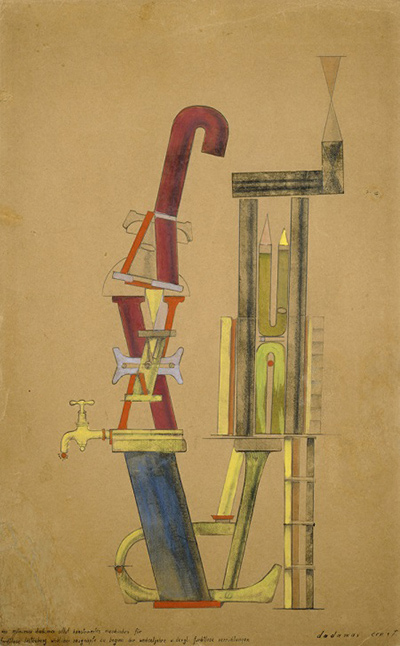The oil painting Little Machine Constructed by Minimax Dadamax in Person is a Max Ernst creation that he did between 1919 and 1920. It's among a series of pieces about scientific instruments by the German artist.
The mixed media artwork is one of the most famous from the painter. He did the diagrams as print reproductions first then used different techniques for colouring and texturing. He mixed gouache, pencil, watercolour. Ink frottage is another method the painter employed to texture the painting. In frottage, the artist rubs surfaces of a different texture on the artwork to create a three-dimensional look. Ernst executed the painting in Cologne during the introduction of the Dada movement.
The painting consists of an interconnected lab device with two sides. On the right section of the artwork is an angular installation. It looks like two U-tubes, one facing down and the other facing the opposite side. They seem to have some liquid. Tubes extend from this first setup to the second one, which is asymmetrical. It has a tap protruding from the bottom section. The rest of the device extends to match its counterpart in height. Its last piece is a large tube that bends at the top such that the mouth faces down the first installation. Ernst used dull colours for the device on the right. It's a blend of dirty yellows and browns. The other one is more vibrant with a combination of blues, maroons and greys.
Little Machine Constructed by Minimax Dadamax in Person represents the sexual pressures that people undergo. The setup on the right shows where the semen production occurs. A red drop on one of the tubes represents the semen. The installation allows the semen to travel to the left side where it's released through the tap. An inscription at the bottom of the artwork affirms this imagery. It tells of the "pollination of female suckers" at the start of life. The mechanical structure symbolises sexual activity. One similar approach to the subject is Very Rare Picture on the Earth by Picabia.
Ernst used some elements of typography in the painting. Some of the pieces in the machine look like letters. It is an interest that Picabia also shared. The letters link to each other seamlessly to show the functioning of the laboratory equipment. Ernst created the left side of the installation to be female while the opposite one is male. The distinction between the two in design and colour is part of the symbolism that the painter tries to depict.




